tow bar VAUXHALL VIVARO C 2020 Owner's Manual
[x] Cancel search | Manufacturer: VAUXHALL, Model Year: 2020, Model line: VIVARO C, Model: VAUXHALL VIVARO C 2020Pages: 289, PDF Size: 10.16 MB
Page 63 of 289

Seats, restraints61geschÞtzt ist, da dies den TOD oder
SCHWERE VERLETZUNGEN DES
KINDES zur Folge haben kann.
FR: NE JAMAIS utiliser un siÃĻge
d'enfant orientÃĐ vers l'arriÃĻre sur un
siÃĻge protÃĐgÃĐ par un COUSSIN
GONFLABLE ACTIF placÃĐ devant lui,
sous peine d'infliger des
BLESSURES GRAVES, voire
MORTELLES Ã l'ENFANT.
ES: NUNCA utilice un sistema de
retenciÃģn infantil orientado hacia
atrÃĄs en un asiento protegido por un
AIRBAG FRONTAL ACTIVO. Peligro de MUERTE o LESIONES GRAVES
para el NIÃO.
RU: ÐÐÐÐ ÐÐĐÐÐÐĒÐĄÐŊ
ŅŅŅÐ°Ð―Ð°ÐēÐŧÐļÐēаŅŅ ÐīÐĩŅŅКÐūÐĩ
ŅÐīÐĩŅÐķÐļÐēаŅŅÐĩÐĩ ŅŅŅŅÐūÐđŅŅÐēÐū ÐŧÐļŅÐūО
Ð―Ð°Ð·Ð°Ðī Ð―Ð° ŅÐļÐīÐĩÐ―ŅÐĩ аÐēŅÐūОÐūÐąÐļÐŧŅ,
ÐūÐąÐūŅŅÐīÐūÐēÐ°Ð―Ð―ÐūО ŅŅÐūÐ―ŅаÐŧŅÐ―ÐūÐđ
ÐŋÐūÐīŅŅКÐūÐđ ÐąÐĩзÐūÐŋаŅÐ―ÐūŅŅÐļ, ÐĩŅÐŧÐļ
ÐÐÐÐĢÐĻÐÐ ÐÐ ÐÐĒÐÐÐŪЧÐÐÐ! ÐŅÐū
ОÐūÐķÐĩŅ ÐŋŅÐļÐēÐĩŅŅÐļ К ÐĄÐÐÐ ÐĒÐ ÐļÐŧÐļ
ÐĄÐÐ ÐŽÐÐÐÐŦÐ ÐĒÐ ÐÐÐÐÐ
Ð ÐÐÐÐÐÐ.NL: Gebruik NOOIT een achterwaarts
gericht kinderzitje op een stoel met
een ACTIEVE AIRBAG ervoor, om
DODELIJK of ERNSTIG LETSEL van het KIND te voorkomen.
DA: Brug ALDRIG en bagudvendt
autostol pÃĨ et forsÃĶde med AKTIV
AIRBAG, BARNET kan komme i
LIVSFARE eller komme ALVORLIGT
TIL SKADE.
SV: AnvÃĪnd ALDRIG en bakÃĨtvÃĪnd
barnstol pÃĨ ett sÃĪte som skyddas med en framfÃķrvarande AKTIV AIRBAG.
DÃDSFALL eller ALLVARLIGA
SKADOR kan drabba BARNET.
FI: ÃLÃ KOSKAAN sijoita taaksepÃĪin
suunnattua lasten turvaistuinta
istuimelle, jonka edessÃĪ on
AKTIIVINEN TURVATYYNY, LAPSI
VOI KUOLLA tai VAMMAUTUA
VAKAVASTI.
NO: Bakovervendt
barnesikringsutstyr mÃĨ ALDRI brukes
pÃĨ et sete med AKTIV
KOLLISJONSPUTE foran, da det kan fÃļre til at BARNET utsettes for
LIVSFARE og fare for ALVORLIGE
SKADER.PT: NUNCA use um sistema de
retençÃĢo para crianças voltado para
trÃĄs num banco protegido com um
AIRBAG ACTIVO na frente do
mesmo, poderÃĄ ocorrer a PERDA DE
VIDA ou FERIMENTOS GRAVES na
CRIANÃA.
IT: Non usare mai un sistema di
sicurezza per bambini rivolto
all'indietro su un sedile protetto da AIRBAG ATTIVO di fronte ad esso:
pericolo di MORTE o LESIONI
GRAVI per il BAMBINO!
EL: Î ÎÎĪΠΞη ÏÏηÏÎđΞÎŋÏÎŋÎđÎĩÎŊÏÎĩ ÏÎąÎđÎīÎđΚÏ
ΚΎÎļÎđÏΞι ÎąÏÏÎąÎŧÎĩÎŊÎąÏ ÎžÎĩ ÏÎŋÏÎŽ ÏÏÎŋÏ ÏÎą
ÏÎŊÏÏ ÏÎĩ ΚΎÎļÎđÏΞι ÏÎŋÏ
ÏÏÎŋÏÏÎąÏÎĩÏÎĩÏÎąÎđ
ÎąÏÏ ÎžÎĩÏÏÏÎđÎšÏ ÎÎÎÎĄÎÎ ÎÎÎĄÎÎĢÎÎÎ, ÎīÎđÏÏÎđ ÏÎŋ ÏÎąÎđÎīÎŊ ΞÏÎŋÏÎĩÎŊ Î―Îą Ï
ÏÎŋÏÏÎĩÎŊ
ÎÎÎÎÎĢÎÎÎ ÎŪ ÎĢÎÎÎÎĄÎ
ÎĪÎĄÎÎĨÎÎÎĪÎÎĢÎÎ.
PL: NIE WOLNO montowaÄ fotelika
dzieciÄcego zwrÃģconego tyÅem do
kierunku jazdy na fotelu, przed
ktÃģrym znajduje siÄ WÅÄCZONA
PODUSZKA POWIETRZNA.
Niezastosowanie siÄ do tego
zalecenia moÅže byÄ przyczynÄ
ÅMIERCI lub POWAÅŧNYCH
OBRAÅŧEÅ u DZIECKA.
Page 192 of 289

190Driving and operatingspeed range and only responds to
detected vehicles and
pedestrians.
System limitations
In some cases, the active emergencybraking system may provide an
automatic braking in situations that
seem to be unnecessary, for instance
in parking garages, due to traffic signs
in a curve or due to vehicles in
another lane. This is normal
operation, the vehicle does not need
service. Firmly apply the accelerator
pedal to override the automatic
braking if the situation and the
surroundings permit.
In the following cases, active
emergency braking performance is
limited:
â Driving on winding or hilly roads.
â Detecting all vehicles, especially vehicles with a trailer, tractors,
muddy vehicles, etc.
â Detecting a vehicle when weather limits visibility, such as infog, rain, or snow.
â Driving during nighttime.
â The windscreen is damaged or affected by foreign items, e.g.
stickers.
Complete attention is always required
while driving, and the driver should be ready to take action and apply the
brakes and / or steer the vehicle to
avoid crashes.
We recommend to deactivate the
system in the vehicle personalisation
in the following cases:
â when towing a trailer or caravan
â when carrying long objects on roof bars or a roof rack
â when the vehicle is being towed with the engine running
â when tyre chains are fitted
â when a spare wheel is fitted that is smaller than the other wheels
â before using an automatic car wash with the engine running
â before placing the vehicle on a rolling road in a workshop
â if the windscreen has been damaged close to the cameraâ if the front bumper has beendamaged
â if the brake lamps are not working
Fault
In case the system requires a service, m is illuminated in the instrument
cluster, a message is displayed in the
Driver Information Centre and an
audible signal is given.
If the system does not work as it
should do, vehicle messages are
displayed in the Driver Information
Centre.
Vehicle messages 3 122.
Front pedestrian protection Front pedestrian protection may help
to avoid or reduce the harm caused
by front-end crashes with pedestrians when driving forward.
The system uses the front camera in
the windscreen and a radar sensor in
the front bumper to detect a
pedestrian directly ahead in your path.
Page 208 of 289

206Driving and operatingBy driving uphill, the temperature of
the coolant is increased. To reduce
heating, drive at a reduced speed and
pay attention to the coolant
temperature. If the control indicator
2 of the engine coolant temperature
gauge illuminates, stop the vehicle
and switch off engine as soon as
possible.
Trailer towing Trailer loadsThe permissible trailer loads are
vehicle and engine-dependent
maximum values which must not be
exceeded. The actual trailer load is
the difference between the actual
gross weight of the trailer and the
actual coupling socket load with the
trailer coupled.
The permissible trailer loads are
specified in the vehicle documents. In general, they are valid for gradients
up to 12%.
The permissible trailer load applies
up to the specified incline and at sea
level. Since engine power decreases
as altitude increases due to the airbecoming thinner, therefore reducing
climbing ability, the permissible gross
train weight also decreases by 10%
for every 1000 metres of altitude. The gross train weight does not have to be
reduced when driving on roads with
slight inclines (less than 8%, e.g.
motorways).
The permissible gross train weight must not be exceeded. This weight is
specified on the identification plate
3 264.
When distributing the loads in the
trailer, heavy objects should be
placed as close as possible to the
axle.
Vertical coupling load
The vertical coupling load is the load
exerted by the trailer on the coupling
ball. It can be varied by changing the
weight distribution when loading the
trailer.
The maximum permissible vertical
coupling load is specified on the
towing equipment identification plate
and in the vehicle documents.Always aim for the maximum vertical
coupling load, especially in the case
of heavy trailers. The vertical coupling load should never fall below 25 kg.
Rear axle load
When the trailer is coupled and the
towing vehicle fully loaded, the
permissible rear axle load (see
identification plate or vehicle
documents) may be exceeded by
60 kg , the gross vehicle weight rating
must not be exceeded. If the
permissible rear axle load is
exceeded, a maximum speed of
60 mph applies.
Towing equipment Depending on version the vehicle canbe fitted with a detachable or a fixed
coupling ball bar.
Type ACaution
When operating without a trailer,
remove the coupling ball bar.
Page 210 of 289
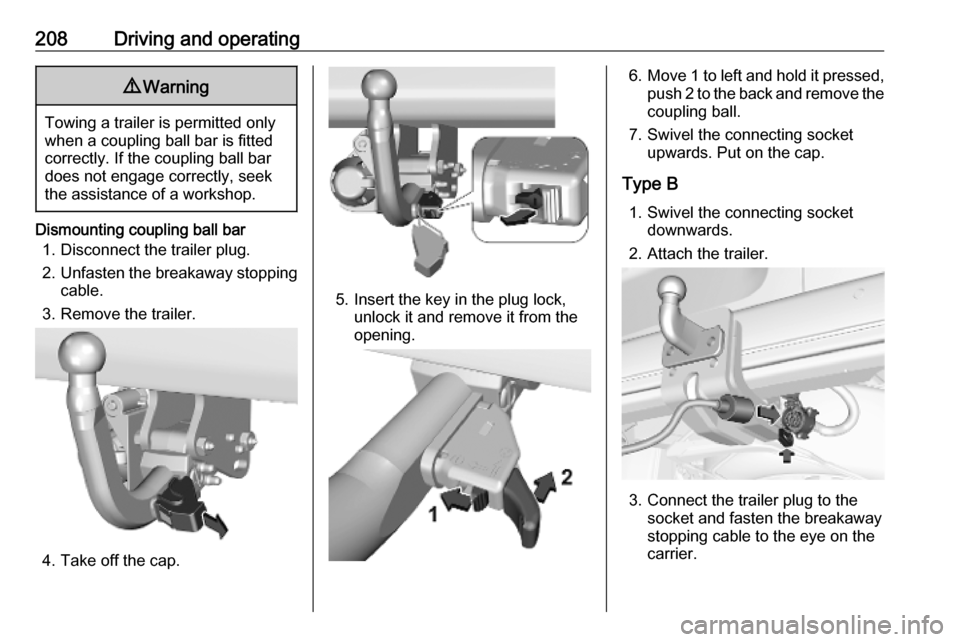
208Driving and operating9Warning
Towing a trailer is permitted only
when a coupling ball bar is fitted correctly. If the coupling ball bardoes not engage correctly, seekthe assistance of a workshop.
Dismounting coupling ball bar
1. Disconnect the trailer plug.
2. Unfasten the breakaway stopping
cable.
3. Remove the trailer.
4. Take off the cap.
5. Insert the key in the plug lock, unlock it and remove it from the
opening.
6. Move 1 to left and hold it pressed,
push 2 to the back and remove the
coupling ball.
7. Swivel the connecting socket upwards. Put on the cap.
Type B 1. Swivel the connecting socket downwards.
2. Attach the trailer.
3. Connect the trailer plug to the socket and fasten the breakaway
stopping cable to the eye on the
carrier.
Page 236 of 289
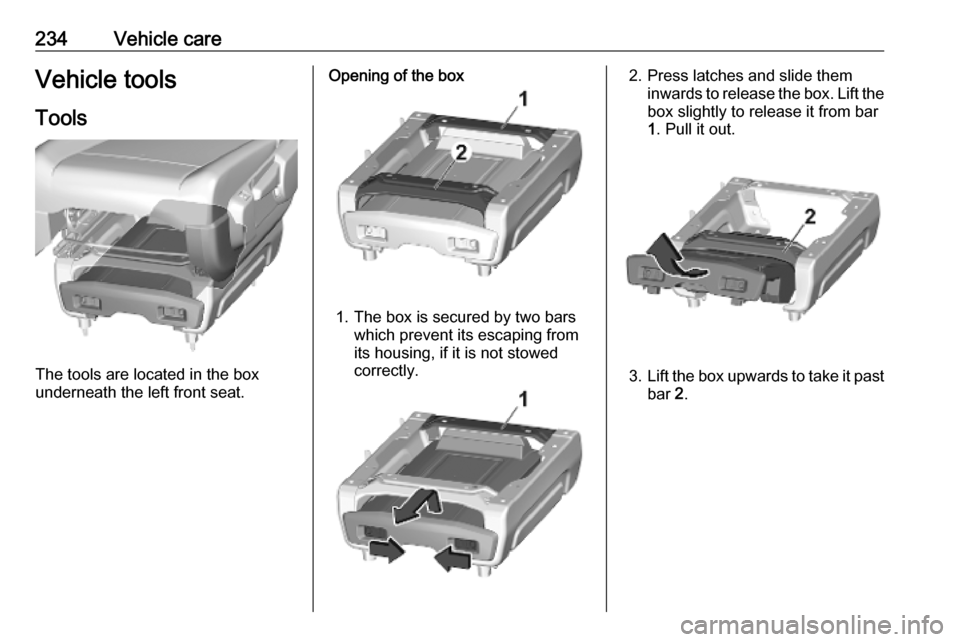
234Vehicle careVehicle tools
Tools
The tools are located in the box
underneath the left front seat.
Opening of the box
1. The box is secured by two bars
which prevent its escaping from
its housing, if it is not stowed
correctly.
2. Press latches and slide them inwards to release the box. Lift thebox slightly to release it from bar
1 . Pull it out.
3. Lift the box upwards to take it past
bar 2.
Page 237 of 289
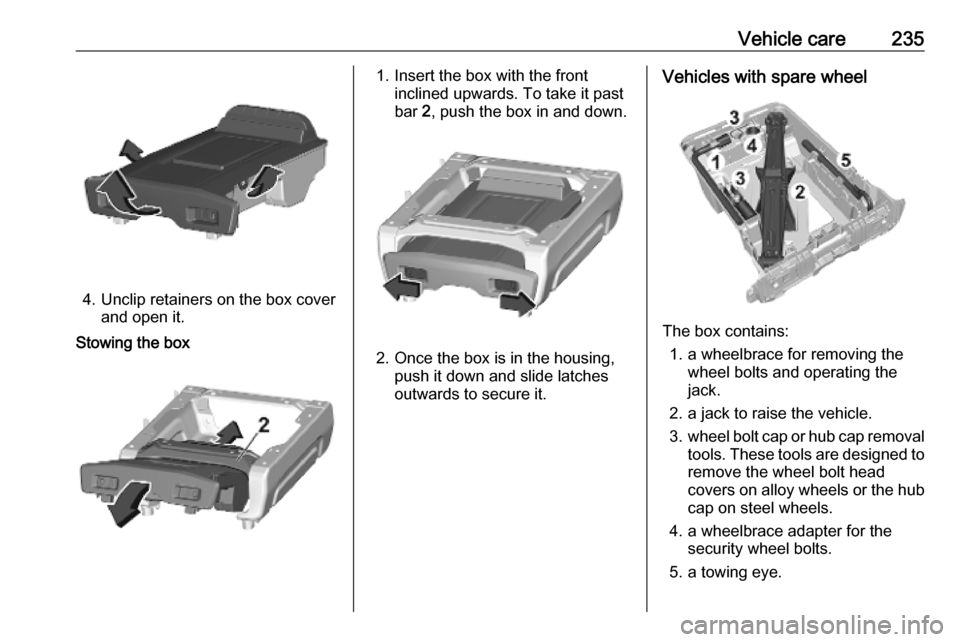
Vehicle care235
4. Unclip retainers on the box coverand open it.
Stowing the box1. Insert the box with the front inclined upwards. To take it past
bar 2, push the box in and down.
2. Once the box is in the housing,
push it down and slide latches
outwards to secure it.
Vehicles with spare wheel
The box contains:
1. a wheelbrace for removing the wheel bolts and operating the
jack.
2. a jack to raise the vehicle.
3. wheel bolt cap or hub cap removal
tools. These tools are designed to
remove the wheel bolt head
covers on alloy wheels or the hub
cap on steel wheels.
4. a wheelbrace adapter for the security wheel bolts.
5. a towing eye.
Page 244 of 289
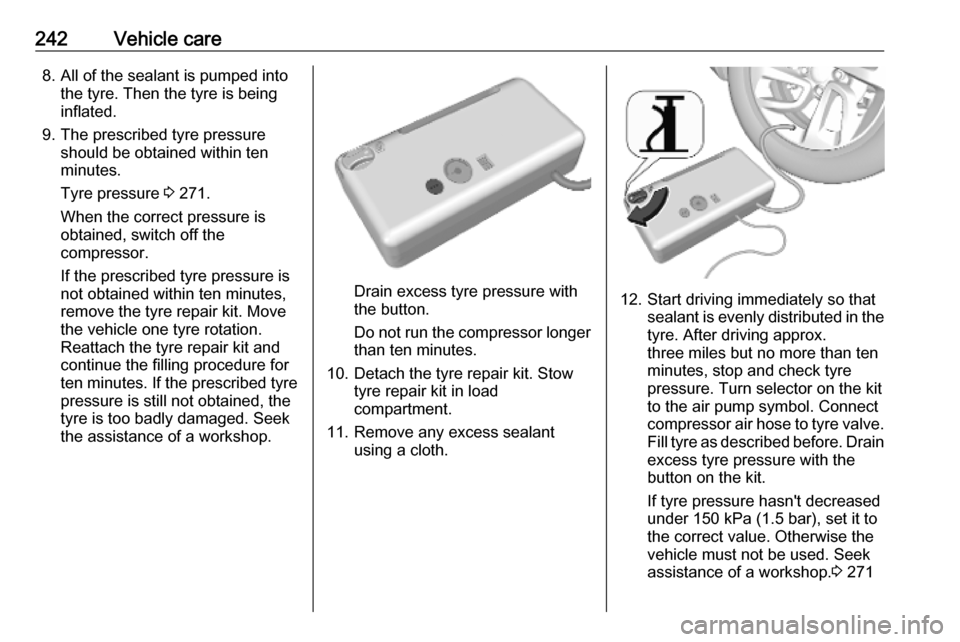
242Vehicle care8. All of the sealant is pumped intothe tyre. Then the tyre is being
inflated.
9. The prescribed tyre pressure should be obtained within ten
minutes.
Tyre pressure 3 271.
When the correct pressure is
obtained, switch off the
compressor.
If the prescribed tyre pressure is
not obtained within ten minutes,
remove the tyre repair kit. Move
the vehicle one tyre rotation.
Reattach the tyre repair kit and
continue the filling procedure for
ten minutes. If the prescribed tyre
pressure is still not obtained, the
tyre is too badly damaged. Seek
the assistance of a workshop.
Drain excess tyre pressure with
the button.
Do not run the compressor longer than ten minutes.
10. Detach the tyre repair kit. Stow tyre repair kit in load
compartment.
11. Remove any excess sealant using a cloth.12. Start driving immediately so thatsealant is evenly distributed in the
tyre. After driving approx.
three miles but no more than ten
minutes, stop and check tyre
pressure. Turn selector on the kit
to the air pump symbol. Connect
compressor air hose to tyre valve. Fill tyre as described before. Drain excess tyre pressure with the
button on the kit.
If tyre pressure hasn't decreased
under 150 kPa (1.5 bar), set it to
the correct value. Otherwise the
vehicle must not be used. Seek
assistance of a workshop. 3 271
Page 245 of 289

Vehicle care243Repeat the checking procedure
once more after driving further
three miles but no more than ten
minutes to check that there is no
more loss of pressure.
If the tyre pressure has fallen
below 150 kPa (1.5 bar), the
vehicle must not be used. Seek
the assistance of a workshop.
13. Stow away tyre repair kit in load compartment.
Notice
The driving characteristics of the repaired tyre are severely affected,
therefore have this tyre replaced.
If unusual noise is heard or the
compressor becomes hot, turn
compressor off for at least
30 minutes.
Note the expiry date of the kit. After
this date its sealing capability is no
longer guaranteed. Pay attention to
storage information on sealant
bottle.Replace the used sealant cartridge. Dispose of the bottle as prescribed
by applicable laws.
The compressor and sealant can be
used from approx. -30 °C.
Removing the pipe and cartridge
1. Turn pipe assembly to the left until
it contacts the unit.
2. Disconnect the connector from the cartridge by turning it a quarter
turn anti-clockwise.
Page 257 of 289
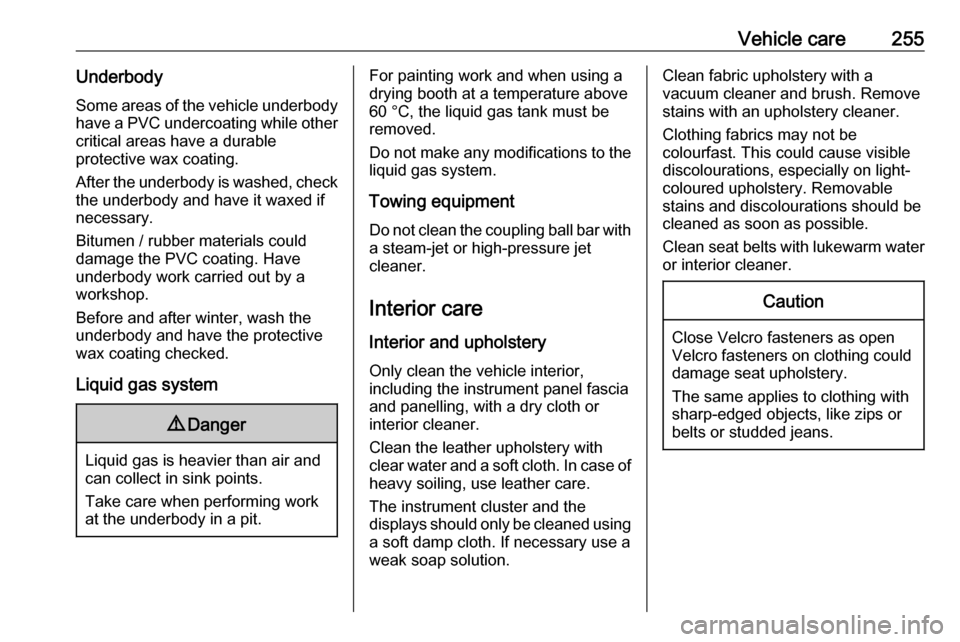
Vehicle care255UnderbodySome areas of the vehicle underbody
have a PVC undercoating while other
critical areas have a durable
protective wax coating.
After the underbody is washed, check the underbody and have it waxed if
necessary.
Bitumen / rubber materials could
damage the PVC coating. Have
underbody work carried out by a
workshop.
Before and after winter, wash the
underbody and have the protective
wax coating checked.
Liquid gas system9 Danger
Liquid gas is heavier than air and
can collect in sink points.
Take care when performing work
at the underbody in a pit.
For painting work and when using a
drying booth at a temperature above
60 °C, the liquid gas tank must be
removed.
Do not make any modifications to the
liquid gas system.
Towing equipment
Do not clean the coupling ball bar with a steam-jet or high-pressure jet
cleaner.
Interior care
Interior and upholstery
Only clean the vehicle interior,
including the instrument panel fascia
and panelling, with a dry cloth or
interior cleaner.
Clean the leather upholstery with
clear water and a soft cloth. In case of heavy soiling, use leather care.
The instrument cluster and the
displays should only be cleaned using
a soft damp cloth. If necessary use a
weak soap solution.Clean fabric upholstery with a
vacuum cleaner and brush. Remove
stains with an upholstery cleaner.
Clothing fabrics may not be
colourfast. This could cause visible
discolourations, especially on light-
coloured upholstery. Removable
stains and discolourations should be
cleaned as soon as possible.
Clean seat belts with lukewarm water or interior cleaner.Caution
Close Velcro fasteners as open
Velcro fasteners on clothing could
damage seat upholstery.
The same applies to clothing with
sharp-edged objects, like zips or
belts or studded jeans.
Page 288 of 289

286Tow bar....................................... 205
Towing ................................ 205, 251
Towing another vehicle .............252
Towing equipment .....................206
Towing the vehicle .....................251
Trailer coupling ........................... 205
Trailer stability assist .................209
Trailer towing ............................. 206
Transmission ............................... 17
Transmission display .................165
Tread depth ............................... 239
Trip odometer ............................ 105
Turn lights .......................... 109, 133
Tyre chains ................................ 240
Tyre deflation detection system . 238
Tyre designations ......................236
Tyre pressure ............................ 237
Tyre pressures ........................... 271
Tyre repair kit ............................. 240
U Ultrasonic parking assist............. 191
Underseat storage .......................79
Upholstery .................................. 255
USB port ....................................... 97
Using this manual ..........................3
V
Valet mode ................................. 119
Vauxhall Connect .......................127
Vehicle battery ........................... 216Vehicle checks............................ 212
Vehicle data ................................ 266
Vehicle data recording and privacy ..................................... 277
Vehicle detected ahead ..............114
Vehicle dimensions .................... 270
Vehicle Identification Number ....264
Vehicle jack ................................ 234
Vehicle locator lighting ...............137
Vehicle messages .....................122
Vehicle personalisation .............123
Vehicle security ............................ 35
Vehicle specific data ......................3
Vehicle storage ........................... 211
Vehicle tools ............................... 234
Vehicle unlocking ........................... 6 Ventilation ................................... 146
W Warning chimes .........................122
Warning lights ............................. 104
Washer and wiper systems .........13
Washer fluid ............................... 215
Wheel changing .........................244
Wheel covers ............................. 240
Wheels and tyres .......................236
Windows ....................................... 41
Windscreen................................... 41
Windscreen wiper and washer ....94Winter tyres ............................... 236
Wiper blade replacement ..........219
X Xenon headlights .......................223